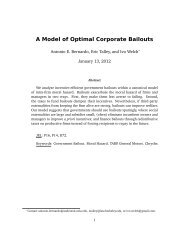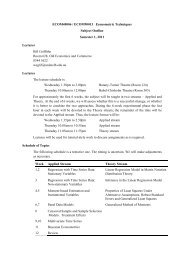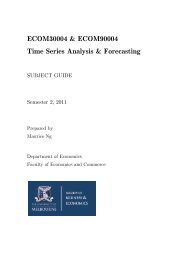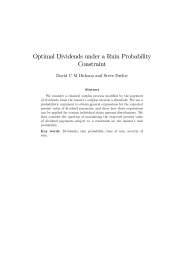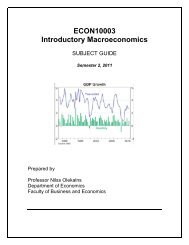Bayesian Inference in the Seemingly Unrelated Regressions Model
Bayesian Inference in the Seemingly Unrelated Regressions Model
Bayesian Inference in the Seemingly Unrelated Regressions Model
Create successful ePaper yourself
Turn your PDF publications into a flip-book with our unique Google optimized e-Paper software.
7<br />
proper, we require T ≥ M + rank( X*<br />
) (Griffiths et al 2001). Also, this pdf is not of a<br />
standard recognisable form. Except for special cases, analytical expressions for its<br />
normalis<strong>in</strong>g constant and moments are not available. Estimat<strong>in</strong>g <strong>the</strong>se moments, and<br />
marg<strong>in</strong>al pdf’s for <strong>in</strong>dividual coefficients β ik<br />
we describe some more pdf’s that will prove to be useful.<br />
, is considered <strong>in</strong> <strong>the</strong> next section; first,<br />
D. Conditional Posterior pdf for ( β 1| β 2,..., β<br />
M )<br />
It is possible to show that <strong>the</strong> posterior pdf for <strong>the</strong> coefficient vector from one<br />
equation, conditional on those from o<strong>the</strong>r equations, is a multivariate t-distribution.<br />
To derive this result, we will consider <strong>the</strong> posterior pdf for β 1 , conditional on<br />
( β , β ,..., β ) . We write a partition of ( Y − X*<br />
B)<br />
<strong>in</strong>to its first and rema<strong>in</strong><strong>in</strong>g<br />
2 3<br />
M<br />
( M − 1) columns as<br />
( 1 1 1 (1))<br />
Y − X*<br />
B= y − X β E<br />
The correspond<strong>in</strong>g partition of A is<br />
⎡( y1− X1β1)( ′ y1− X1β1) ( y1− X1β1 )′<br />
E(1)<br />
⎤<br />
A = ⎢ ⎥<br />
⎢ E ′<br />
(1) ( y1 X1 1 ) E ′<br />
⎣<br />
− β<br />
(1) E(1)<br />
⎥⎦<br />
Us<strong>in</strong>g a result on <strong>the</strong> determ<strong>in</strong>ant of a partitioned matrix, we have<br />
−<br />
(( )( ′ ) ( )′<br />
( ′ ) )<br />
1 ( )<br />
A = E ′ E y − X β y − X β − y − X β E E E E ′ y − X β<br />
(1) (1) 1 1 1 1 1 1 1 1 1 (1) (1) (1) (1) 1 1 1<br />
Def<strong>in</strong><strong>in</strong>g<br />
Q = I − E E ′ E E ′, and<br />
−1<br />
(1) T (1) ( (1) (1) ) (1)<br />
β # = ′ ′ <strong>the</strong> second<br />
1<br />
1 ( X1 Q(1) X1)<br />
− X1 Q(1) y1<br />
term <strong>in</strong> <strong>the</strong> above equation can be written as<br />
( y − X β )′ Q ( y − X β ) = ( y − X β # )′ Q ( y − X β # ) + ( β − β # )′<br />
X ′ Q X ( β − β # )<br />
1 1 1 (1) 1 1 1 1 1 1 (1) 1 1 1 1 1 1 (1) 1 1 1



